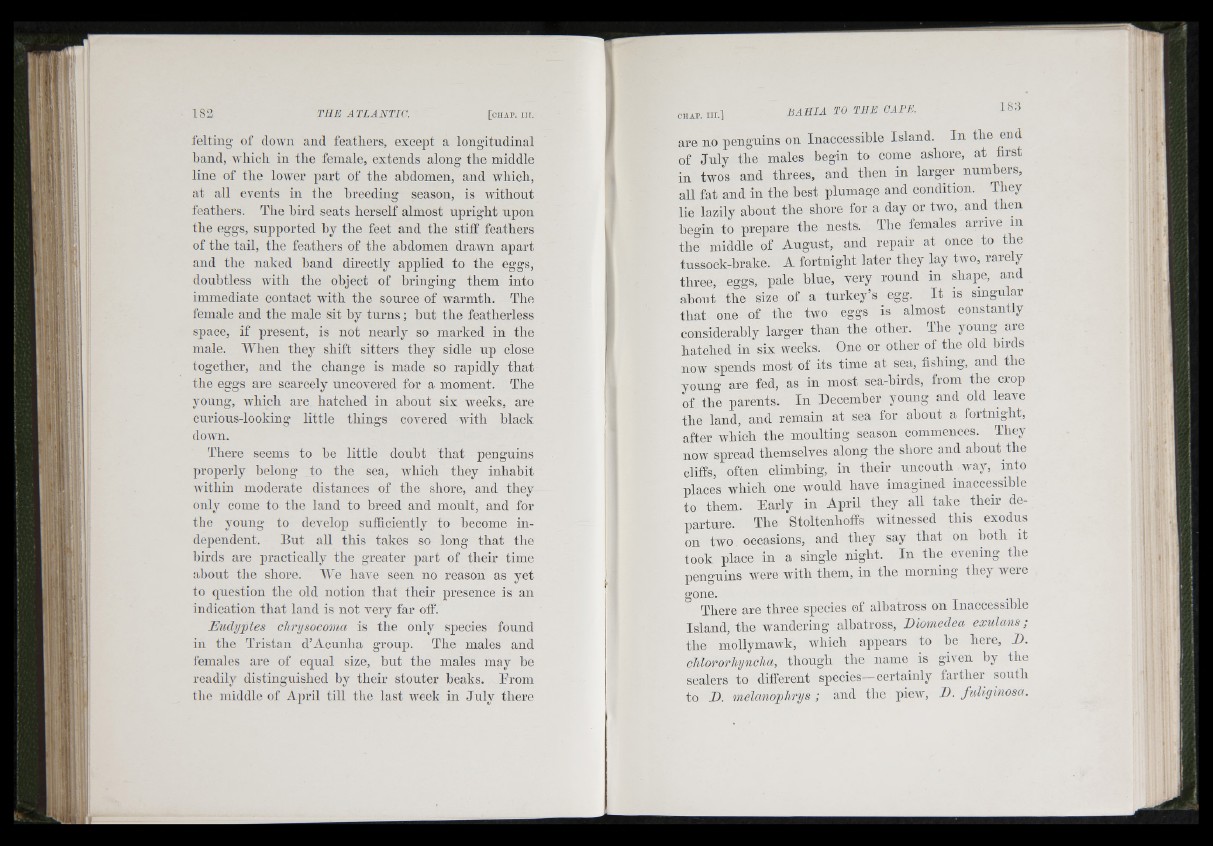
‘Îî
felting of down and feathers, excejit a longitudinal
hand, aa hich in the female, extends along the middle
line of the loAA'er jiart of the abdomen, and Avhich,
at all eA'ents in the breeding season, is AA'ithout
feathers. The hird seats herself almost upright upon
the eggs, supported hy the feet and the stiff feathers
of the tail, the feathers of the abdomen draAA'n ajiart
and the naked hand directly applied to the eggs,
doubtless AA'ith the object of bringing them into
immediate contact AAuth the source of AA'armth. The
female and the male sit hy turns ; but the featherless
space, if present, is not nearly so marked in the
male. IVhen they shift sitters they sidle np close
together, and the change is made so rapidly that
the eggs are scarcely nncoA'ered for a moment. The
young, AA'hich are hatched in ahout six weeks, are
curions-looking little things coA'ered AA'ith hlack
dOAA'U.
There seems to he little donht that penguins
properly belong to the sea, AAdiich they inhabit
AA'ithin moderate distances of the shore, and they
only come to the land to breed and moult, and for
the young to dcA'elop sufficiently to become independent.
But all this takes so long that the
birds are practically the greater part of their time
about tbe shore. We liaA'e seen no reason as yet
to question the old notion that their presence is an
indication that land is not very far off.
Eudyptes chrysocoma is the only species found
ill the Tristan d’Acunha groiij). The males and
females are of equal size, hut the males may he
readily distinguished by tbeir stouter beaks. Erom
the middle of April till tbe last Aveek in July there
are no penguins on Inaccessible Island. In the mid
of July the males begin to come ashore, at first
in twos and threes, and then in larger numbers,
all fat and in the best plumage and condition. They
lie lazily about the shore for a day or two, and then
begin to prepare the nests. The females arrive iii
the middle of August, and repair at once to the
tnssock-hrake. A fortnight later they ffiy tivo, rarely
three, eggs, pale blue, very round in shape, and
about the size of a turkey’s egg. It is singular
that one of the tAVO eggs is almost constantly
considerably larger than the other. The young are
hatched in six weeks. One or other of the old birds
now spends most of its time at sea, fishing, and the
young are fed, as in most sea-hirds, from the crop
of the parents. In Decemher young and old leave
the land, and remain at sea for ahout a fortnight,
after Avhich the moulting season commences. They
now spread themselves along the shore and about the
cliffs, often climbing, iu their uncouth Avay, into
places which one would have imagined inaccessihle
to them. Early in April they all take ^ their departure.
The Stoltenhoffs Avitnessed this exodus
on two occasions, and they say that on hoth it
took place in a single night. In the evening the
penguins were AA'ith them, in the morning they were
gone.
There are three s]3ecies of albatross on Inaccessible
Island, the wandering albatross, Diomedea exulans;
the mollymawk, Avhich appears to he here, X>.
cliloroidiyncha, though the name is given by tbe
sealers to different species—certainly farther south
to _£>. melanoplirys ; and the picAV, D. fuliginosa.